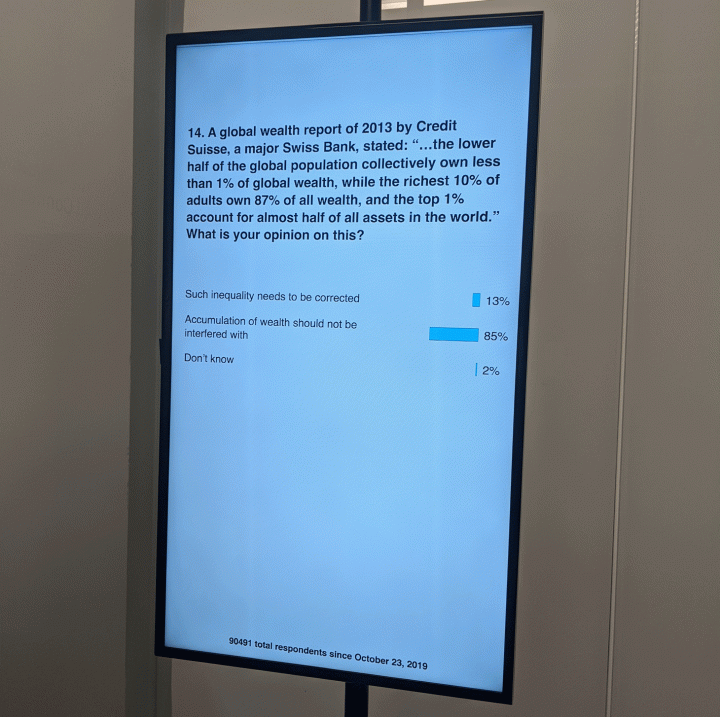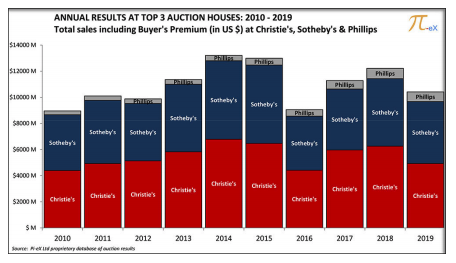Future Look: Contemporary Art World
If the commencement of the new millennium for the 2020 Art World started with a note of optimism, there are mixed-messages embedded within the broader art market and contemporary art ecosystem, which suggests future trends and projections one can anticipate in the coming year from a cultural and market standpoint.
5Pointz in January 2013. Photo courtesy of Ezmosis via Wikimedia Commons.
1) THE AFTERMATH: LANDMARK VISUAL ARTISTS RIGHTS ACT (VARA) RULING UPHELD
The 2019 Appeal of the historic 5Points vs. G&M Realty case, which was denied on all counts by the Appeals court, has proven to be a legal landmark for visual artists' moral rights. For the 21 artists who sought their creative rights against the mutilation of their aerosol works at the iconic 5Pointz in Queens. This ruling validates street art and holds promise to empower future generations. Such effects had already begun to transform the marketplace since Judge Block's original ruling in 2018. Insurance companies, lawyers, dealers, conservators, and collectors began to acknowledge a shift in the power dynamics between property rights and moral rights, which are now on equal ground. We should expect to see more formal compliance with VARA, and it is likely we will see more artists emboldened to preserve their creative rights against corporations or collectors who misuse their creative capital, whether it be through public legal forums or market mechanisms.
For more on this subject see:
https://news.artnet.com/art-world/5pointz-ruling-upheld-1782396
https://www.nytimes.com/aponline/2020/02/20/nyregion/ap-us-nyc-graffiti-ruling.html
https://www.courthousenews.com/court-upholds-massive-judgment-for-5pointz-graffiti-artists/
Nan Goldin and members of P.A.I.N. outside Purdue Pharma headquarters. Erik McGregor/LightRocket via Getty Images
2) ARTISTS & ART FOR SOCIAL CHANGE
As it relates to creative empowerment, I expect that in 2020, artists will continue to take to the social space in trying to create dynamic and significant societal change. No longer relying on mere aesthetics, art markets, or governance to transform, artists have found the power within their own social and collective space. Whether it be through old-fashioned activism and protest, such as the likes of Nan Goldin's PAIN organization calling for museums’ responsible patronage, the Unionizing of Workers at The New Museum, or the digital flexing by REVOK who took to Instagram to protect his copyright, we will continue to see artists take to the social space to weigh into the political arena.
For more on this subject see:
https://observer.com/2019/12/nan-goldins-guggenheim-die-in-is-a-time-magazine-photo-of-the-year/
https://www.nytimes.com/2018/01/22/arts/design/nan-goldin-oxycontin-addiction-opioid.html
https://news.artnet.com/art-world/revok-hm-ad-campaign-1345127
https://www.artnews.com/art-news/news/new-museum-union-contract-agreement-13311/
The hackers hiked up the number of responses from about 14,000 to over 70,000 | Image Courtesy of Hyperallergic
3) HACKING AS AN AESTHETIC PRACTICE
Hacking is not just for criminals anymore - it has taken an increasing aesthetic and cultural role to encourage artists to galvanize critical dialogues. Hacking, in all its forms, has now become an accepted style, critical process, methodology, and performative strategy within the art world, echoing the 1970’s French Situationists and taking cues from Hans Haacke's "Institutional Critique." Wade Guyton, for instance, gained art world visibility for his actions in 2014, when he chose to "hack" his own marketplace by posting in Instagram his newly minted editions of a work that was flipped by a speculating collector at auction. Another emblem of this trend by two artists, who, on the last day of the recent Hans Haacke exhibition at the New Museum, hacked and unlocked the museum's information systems. Their goal was to provoke privacy chaos and thereby make contemporary critiques on the "efficacy" of institutional critique, which is now so embedded in the power structures of the art world. Their action, both political and aesthetic, suggested that optics are a weak substitute to museums which should be making systemic changes in their relationship to the art market ecology.
For more on this subject see:
https://www.vulture.com/2014/05/wade-guyton-may-be-torpedoing-his-own-sales.html
https://hyperallergic.com/538413/hans-haacke-gets-hacked-by-activists-at-the-new-museum/
Leah Schrager, Flashburn, 2017.COURTESY THE ARTIST
4) RETURN TO FIGURATION
On an aesthetic level, expect to see more of the reclamation of the female body by female artists, a focus within activist art that has a long lineage from female artists who were seemingly invisible from the 1970’s feminist art movement, the 1980’s Culture Wars in America and the 1990’s Post-Feminist artists. Generations of artists have focused on exposing the male gaze, its artifice surrounding the aesthetics of the female body, ij order to develop a more fluid, expansive and inclusive art historical canon. Perhaps not soon enough, one will witness more and more figurative art surrounding this concern and is entangled within larger questions of social justice in the privileged art world.
For more on this subject see:
https://www.artsy.net/article/artsy-editorial-body-issues-pleasures-painting-skin
https://www.artnews.com/art-news/artists/leah-schrager-artist-cam-girl-interview-1202673901/
https://www.artnews.com/art-news/news/park-avenue-armory-100-years-100-women-1202678348/
https://www.moma.org/learn/moma_learning/themes/investigating-identity/the-body-in-art/
Yale University Art Gallery in New Haven, Connecticut, 2010. | Image Courtesy of ArtNet
5) REWRITING OF THE WESTERN CANON
In tandem, 2020 will bare witness to an active rewriting of the art historical parqdigm by institutions who finally are proactively questioning the western-centric, patriarchal, and hetero-normative canon. Thus, we will watch an increasing acceleration of acquisitions, programming, and collectors' appetite within the art market for artists of color, LGBT, and geopolitical diversity all with the explicit mandate to expand and diversity the voices which echo within the dominant art world institutions. Also, galleries and thus the marketplace will continue to race to find the best representatives which confronts social justice and weighs actively within identity politics. Perhaps most symbolic of this rewriting was Yale's announcement that it would no longer teach Western Survey Courses, as the number 1 art history department in the US makes efforts to formally recognize the grossly imbalanced and systematically biased means by which art history was written. The call for rewriting the canon is now being answered.
For more on this subject see:
https://observer.com/2020/01/yale-art-history-curriculum-western-canon/
https://news.artnet.com/art-world/yale-art-history-eliminating-survey-course-1763082
Balloon Monkey © Jeff Koons
6) ART AS AN EXPERIENCE, NOT BLING
Perhaps a reaction to our immersion in digital culture, both art audiences and art collectors are seeking art with experiential qualities as the experience economy reverberates within the white cube. Forms of art which lend a tactility or hold a more universally transformational power and inclusive message - speaks to the new generations of Millenials and Zs. Perhaps as a counter-reaction to the need for art with meaning, we will witness a lessening on the critical reception of art as artifice, art as design and art with "finish fetish" as exemplified by the omce technical wonders of Koon's Celebrity Series, which its glory has faded in the ubiquitous access to and use of digital printing and 3D design fabrication processes. Walter Benjamin's revolutionary ideas regarding the art of mechanical reproduction has now lost its appeal or "aura" as an object. Art as a commodity or as a luxury has finally shaken off its 1990’s glitz, as more diverse audiences and collectors alike have unlimited access to products via technological distribution and thus demand something "other than" from the art market and its purveyors. In my view, it is an exciting time for dealers, curators, and art institutions that have established themselves in this space to exhibit and support "difficult art" rather than promoting art as bling, swag, or mere commodity to reach a new found demand for art that's meaningful and memorable.
For more on this subject see:
JR’s Installation at the Louvre | Image Courtesy of the Artist
7) THE ATTENTION ECONOMY
As millennials receive much focus from the cultural economy as an important audience - arts institutions, galleries, and museums are pushing harder to satisfy the business of the "experience economy". Not only are there now Instagram "set-ups" embraced by even the stuffiest public museums, such as the Metropolitan's selfie stations, but ome finds an increase in the exhibition and curatorial focus on ephemeral forms such as performance art, installation art, art auctions, and art takeovers. Following the global sensation of icon Yayoi Kusama, whose solo museum and gallery shows have surpassed her male colleagues' popularity, more passive and traditional art forms have become secondary in museum attendence in both East and West viewership. Kusama's body of work has brought a wave of attendance and creates authentic "new viewers" to the art world, her popularity typically known only to rock stars and celebrities. Thus, the art world pushes hard to deliver new talents and more exhibitions that will reach the ever-growing interest in art such as JR at the Louvre. This represents a renewed artistic spirit within the staid museum world wherein alternative forms of art are embraced, and creativity in curating is at its best, as it prioritizes the viewer's experience and the artist’s integrity over the authority of institutional thought.
For more on this subject see:
https://hypebeast.com/2019/4/jr-installation-musee-du-louvre-destroyed-shreds
Courtesy of Pi-ex 2010- 2019 Annual Report
8) STATE OF THE MARKET: BUYERS' MARKET
The data is out. Year over Year, the art market in 2019, has taken a slide as measured by auction sales volumes, which is the most reliable measure of art market activity. A research study suggested that the art market has taken, in the West, at least (as Asian markets are more resistant to reliable measurement due to their lack of transparency and regulation) that there has been a 15% decrease in buyers. Although not representing a complete recession, but rather a soft slide, the market has flipped to become a "Buyers' Market" and typically empowers the most prominent collectors, who know buying great art in such times is an opportunity to gain access to the best and most representative artists. Such times also present great opportunities and increased accessibility for rising collectors as art fairs and galleries are apt to be more open-minded to newcomers, a little less persnickety, and somewhat more negotiable in transactions. Either way, a Buyers' Market, and opportunity abounds for those who do their homework.
For more on this subject see:
https://www.wsj.com/articles/bargain-hunters-rule-the-art-market-11573992000
https://news.artnet.com/market/tad-smith-sothebys-legacy-1692742
The experimental Signals Gallery lasted just two years in the mid 1960s © Clay Perry, England & Co Gallery, London
9) GALLERIES EXPERIENCING INCREASED BUSINESS PRESSURES
We will continue to watch the “middle market” get pressured wherein the middle-level dealer continues to struggle to balance the increased operating costs of business, the relentless resource drain of traveling art fairs, and the never-ending threat of losing their star artists being poached by the top 10 galleries. The biggest and best galleries, well known to many, will continue to wield tremendous market power; in curatorial selections at the museum; sponsorship underwriting of major public art; and expansive press reach to journalists and mass media, not to mentioned SEO searches. As their resources and influence run unchecked in the cultural space, especially the US public museums, which in the absence of governmental suppport and the ever increasing operating costs mass, the artists’ adage “form follows funds” now resounds loudly.. An economic climate as such has led many smaller galleries, especially those of emerging talent, to call for a "new system" that provides" alternative channels" and "new models" within a market structure and echose the early 1990’s art world which bore the art fair venues. Perhaps such efforts will afford the same innovation, spawning new ideas such as the Grammercy Art Fair, which will disrupt how people view and buy art.
For more on this subject see:
https://www.theartnewspaper.com/feature/london-s-lost-galleries
https://news.artnet.com/market/how-the-art-world-became-the-art-industry-1710228
The facade of Gagosian, courtesy of Shutterstock.
10) MEGA-COLLECTORS' INCREASING INFLUENCE
In regards to the state and ecology of collectors, we will continue to see the influence of the mega-collector, who create demand, shape taste and culture, actively patronize exhibitions and support scholarship. Their recent impetus to build significant private art spaces with extensive public programming is perhaps to the great chagrin of museums. For instance, the opening of the new Brant Foundation, the expansion of Glenstone, the active Broad, as well as the Hill Foundation, serve as examples of this alternative patronage which eschews traditional patronage of public museums. The more successful these private institutional collections are in operating their robustly self-funded organizations with creative programming and public access, the more collectors foresee it as a more sustainable model to historic museum patronage. This trend is gaining more momentum now in America, given the particularly challenging political landscape which rejects challenging visual art and the art world stands witness to Washington's withering funding the arts.
For more on this subject see:
https://www.artspace.com/magazine/interviews_features/expert_eye/fix-the-art-world-quoted-54474
https://www.nytimes.com/2018/03/22/arts/small-galleries-art-market.html
British Pound currency bank notes. Photo illustration by Dinendra Haria/SOPA Images/LightRocket via Getty Images.
11) ART MARKET REGULATIONS
Perhaps the most profound policy change in the art market that is now being felt worldwide is due to new European laws surrounding money laundering and the need for art sellers and buyers to prove their funding to complete the legal sale of an artwork. Called "KYC" – or "Know Your Customer" – the art market is experiencing new legal restrictions on the opaqueness of buyers and sellers. The big auction houses have been preparing for such for some time, and their corporate structure is likely to respond efficiently as some of these measures are already in place within that marketplace. Nevertheless, the effects of such transparency efforts are the topic of concerned discussions throughout Chelsea galleries, as mega dealers are anticipating that whether these laws formally hit the shores of the United States or not, they will need to comply. As the bedrock of their businesses is international transactions performed at top speed, whether the sale or gallery is based in the US, galleries anticipate they will have to adhere to such requirements to provide continuity. This will predictably slow down the speed at which transactions take place, and perhaps impact extreme impulsive buying at fairs, due to the fact that dealers are required to confirm the source of payment for existing and new clients. It seems no gallery is looking forward to that administrative red-tape because the ease of doing business is at the heart of successful dealing in today's market, which is no doubt, driven to distraction. However, as mega-dealers have extensive resources to handle such administrative requirements with white-gloves, one believes its real impact will most painfully be felt by smaller galleries and advisory business, further imbalancing the art ecosystem and tipping the scales and exacerbating the myriad of their challenges to flourish in a global marketplace.
For more on this subject see:
https://news.artnet.com/market/anti-money-laundering-regulations-uk-1749087
https://www.artsy.net/article/artsy-editorial-anti-money-laundering-legislation-impact-art-market
Carol S. Dweck, Ph. D., Graphic by Nigel Holmes
12) ROLE OF CREATIVITY IN CAREER SUCCESS
2020 Started on a positive note with a renewed appreciation for the role of creativity, as many recent studies have suggested the importance of it increases flexible mindsets, critical thinking, and independent thought. One study suggested and made this link to career success, suggesting a fluid mindset benefits one's lifetime career trajectory and long-term success in the workforce.
For more on this subject see:
https://www.forexlive.com/Education/!/the-growth-mindset-of-a-trader-20200215












